Many people know Iowa for its state fair, as the birthplace of sliced bread, and — of course — never-ending fields of corn. However, there’s more to the Hawkeye State than its history, culture, and commerce. The state is also home to many beautiful plants and animals. White-tail deer and foxes roam across its prairies, while otters play in its streams and lakes. Iowa is also home to more than 40 different kinds of spiders, with 16 species being unique to Iowa alone. From tiny jumping spiders to giant wolf spiders, many different arachnids crawl around its gardens and inside people’s homes. Here is a list of 10 spiders in Iowa commonly found throughout the state.

#10: Tuft-Legged Orb Weaver
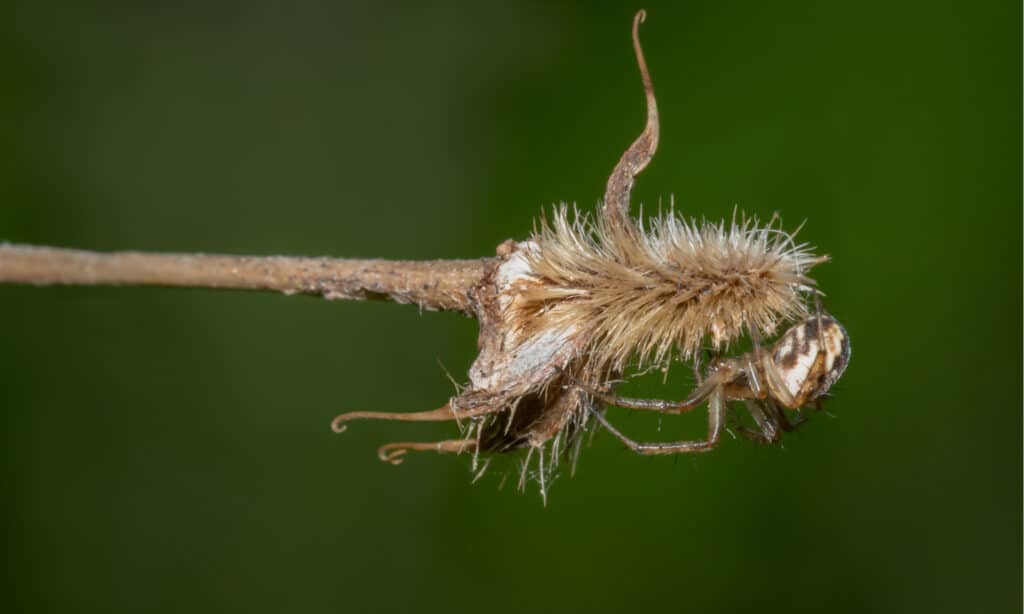
The tuft-legged orb weaver sports long hairs on its legs that help it to manage the fine silk used in its web.
©Paul Reeves Photography/Shutterstock.com
The tuft-legged orb weaver, Mangora placida, belongs to the orb weaver family Araneidae. You can find these hairy-legged spiders in Iowa as well as throughout much of the United States, Canada, and Mexico.
Most adult tuft-legged orb weavers measure between 5 and 7 millimeters long, with females measuring larger than males. Their bodies appear mottled brown, a trait that allows them to easily blend into the woodlands where they typically build their webs. They have long, spiky hairs on their legs, which is where they get their name.
Tuft-legged orb weavers build finer, more tightly woven webs than most other orb weavers. This structure allows them to catch smaller insects and they are able to manage the fine silk due to the hairs on their legs. Due to their small size, they pose little threat to humans.
#9: Southern Black Widow
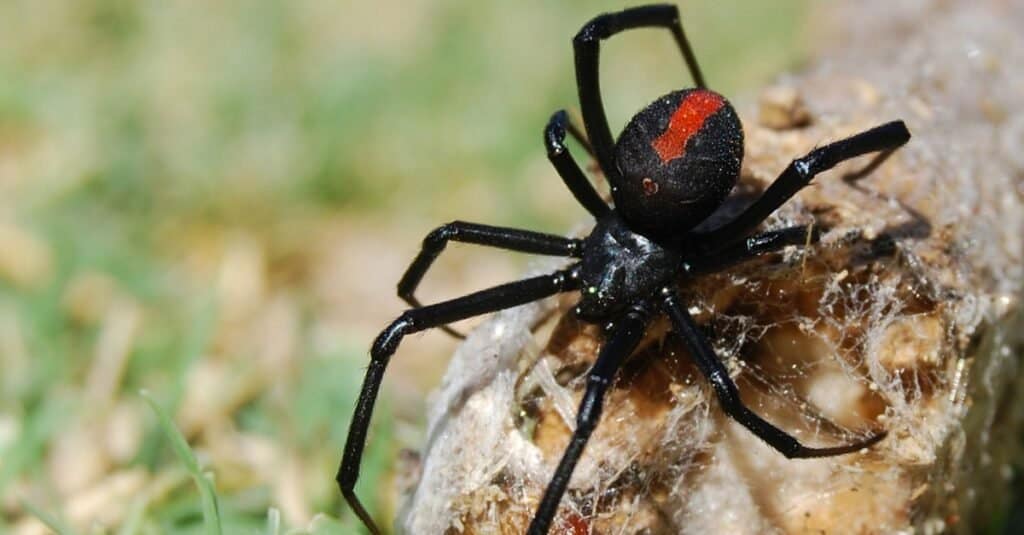
Southern black widow spiders feature a distinctive red hourglass marking on their abdomens.
©iStock.com/maria72
The southern black widow is one of the most venomous spiders in Iowa. A member of the cobweb spider family Theridiidae, it is widely distributed throughout the southern United States as well as Canada and the Dominican Republic.
Females typically measure between 8 and 13 millimeters long, while males measure from 3 to 6 millimeters in length. Females are almost completely black aside from the distinctive red hourglass-shaped marking on their abdomens. Meanwhile, males appear either purple or greyish-black with white stripes and yellowish-orange spots.
Southern black widows build extremely strong, large, three-dimensional cobwebs that they use to capture prey. Their bite contains powerful venom that affects their prey’s nervous system. Although rarely fatal, their bite can cause pain, nausea, muscle aches, and difficulty breathing.
#8: Barn Funnel Weaver
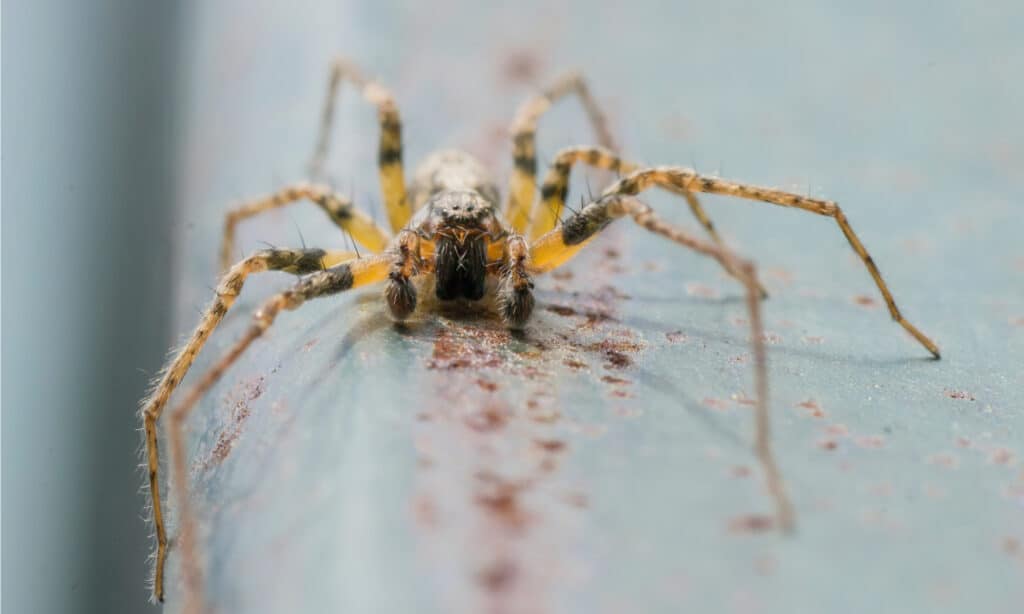
The barn funnel weaver also goes by the name domestic house spider in Europe.
©Korovko Gleb/Shutterstock.com
The barn funnel weaver, Tegenaria domestica, belongs to the funnel-web spider family Agelenidae. It’s one of the most common spiders in Iowa and is also widely distributed throughout Europe, North Africa, and Central Asia. In Europe, it goes by the name domestic house spider.
Female barn funnel weavers measure between 7 and 11 millimeters long and males measure 6 to 9 millimeters long. Their bodies are quite long and they possess straight rather than rounded abdomens. They appear mostly light brown, while their abdomens are gray-brown with a dark stripe down the middle.
Barn funnel weavers build funnel-shaped webs to catch their prey. They are active hunters that rely on quick movements to subdue prey that fall into their webs. They aren’t known to be aggressive and tend to flee from bright lights. Their bite is not considered dangerous to humans.
#7: Woodland Jumping Spider
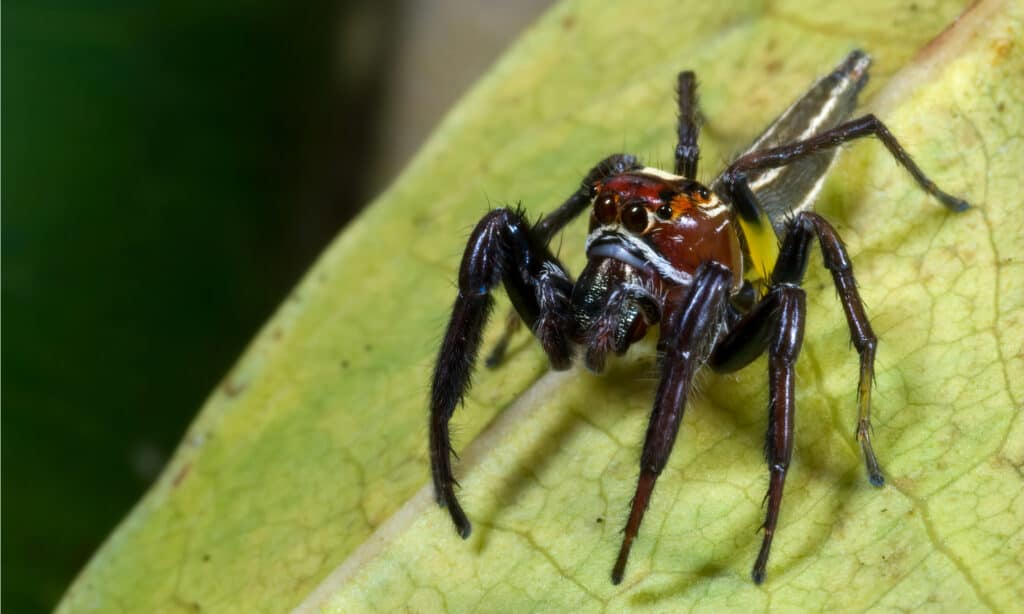
The woodland jumping spider often waits on leaves or branches to ambush prey.
©Gerry Bishop/Shutterstock.com
The woodland jumping spider, Thiodina sylvana, is one of the smallest yet mightiest spiders in Iowa. It is a member of the jumping spider family Salticidae and is widely distributed throughout the United States, Mexico, and Canada.
Adult woodland jumping spiders measure between 3 and 15 millimeters long, with females measuring larger than males. Their carapaces are glossy black and feature a white dot in the center. Each of their eyes is ringed with red and two wavy lines run under each eye around the sides of their heads. Meanwhile, their abdomens are covered in brown hairs and sport two white dashes down the middle.
Woodland jumping spiders are famous for their keen eyesight and leaping abilities. You can often find them on leaves or branches waiting to leap upon unsuspecting prey. Due to their small size, their bite poses little threat to humans.
#6: Dark Fishing Spider
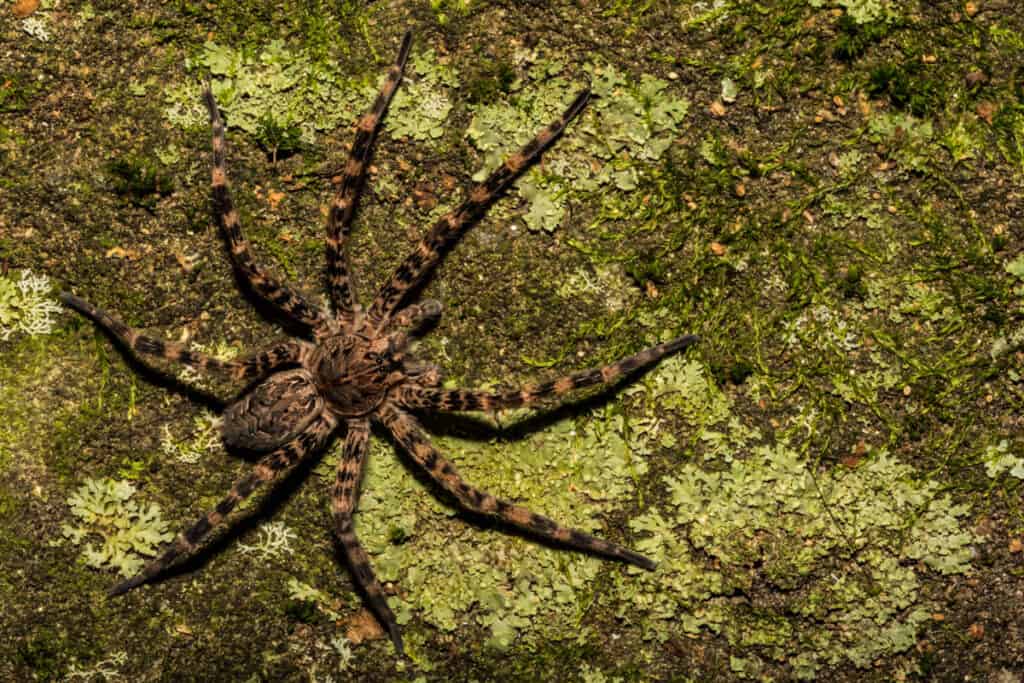
The dark fishing spider can run across the surface of water or dive into the water to catch prey.
©iStock.com/JasonOndreicka
The dark fishing spider, Dolomedes tenebrosus, is one of the most misunderstood spiders in Iowa. This large, hairy spider belongs to the nursery web spider family Pisauridae. It is widely distributed throughout the central and eastern United States and Canada. Due to their large size, many people fear them, but they are relatively harmless.
Female dark fishing spiders can reach nearly 2.5 centimeters long, and males grow to about half that size. They typically appear light brown or grey and have legs covered in dark spots and spines. Their abdomens feature distinctive, dark W-shaped markings.
You can typically find dark fishing spiders near water, although they also spend a lot of time in wooded areas. They stalk their prey both on land and in the water. They can run across the surface of the water after insects as well as dive beneath the surface to catch small fish.
#5: Giant Lichen Orb Weaver
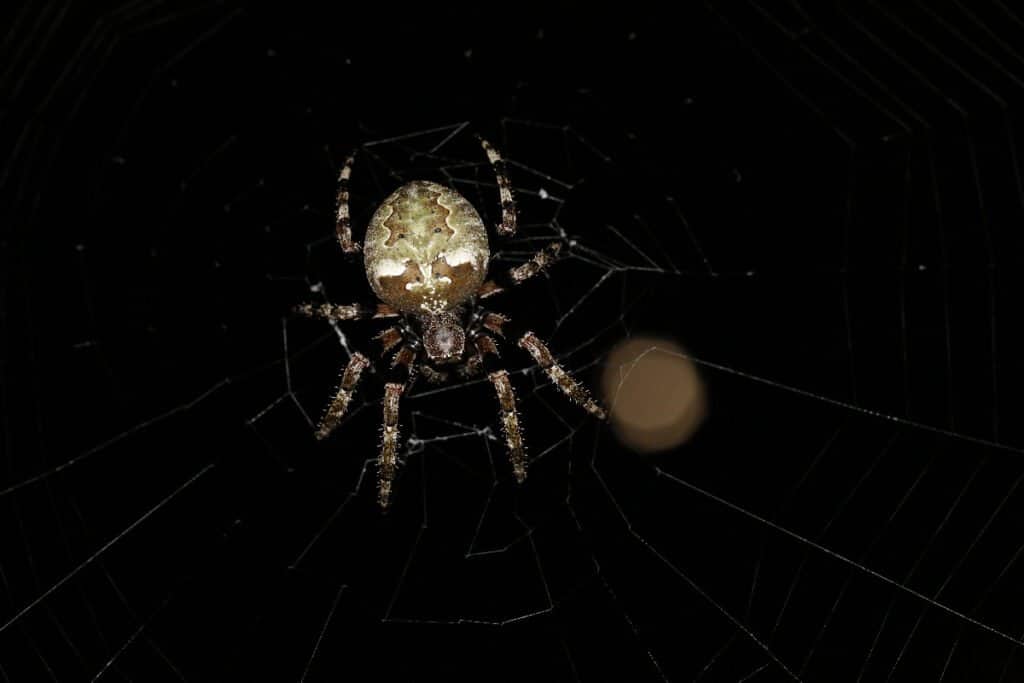
The giant lichen orb weaver creates webs nearly 8 feet wide.
©Cathleen Wake Gorbatenko/Shutterstock.com
Araneus bicentenarius, or the giant lichen orb weaver, is the second member of the Araneidae family to make our list of 10 spiders in Iowa. You can find these massive orb weavers throughout the central and eastern United States along with parts of Canada.
Adult giant lichen orb weavers can reach up to 24 millimeters long, with females measuring larger than males. Their legs feature orange and black bands while their abdomens appear greyish-green with black and white markings. They are often mistaken for European garden spiders, which are distinguishable by their cross-shaped markings.
Aside from their size, giant lichen orb weavers get their name from their huge webs, which can measure nearly 8 feet in diameter. They are most active at night, preferring to hide in the corners of their webs during the day. Despite their size, their bites are harmless, causing little more than some pain and redness.
#4: Carolina Wolf Spider
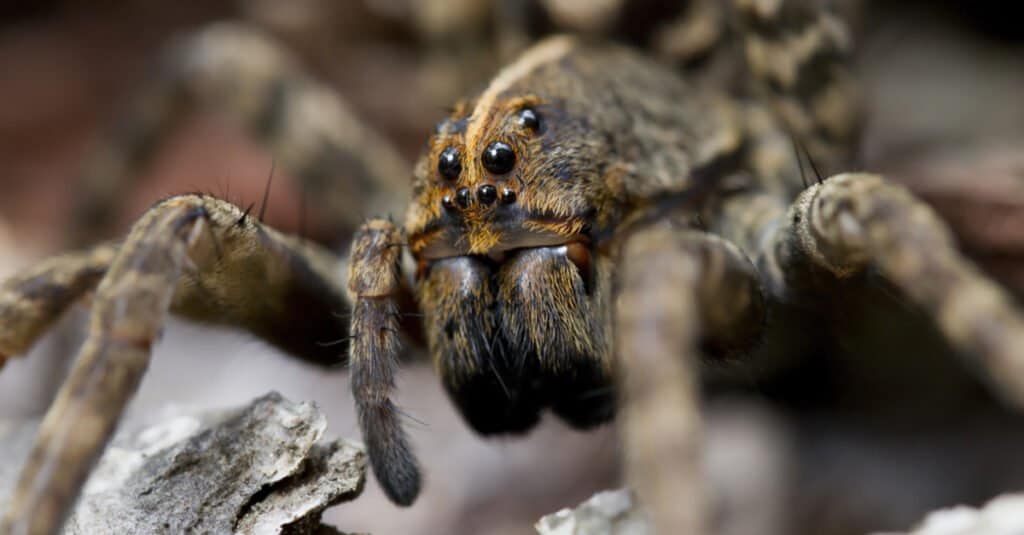
Forest wolf spiders can measure up to 50 millimeters long from tip to tip.
©Will E. Davis/Shutterstock.com
The Carolina wolf spider, Hogna carolinensis, is one of the largest (if not the largest) spiders in Iowa. It is a member of the wolf spider family Lycosidae and is widely distributed throughout North America.
Female Caroline wolf spiders measure between 22 and 35 millimeters long, while males measure 18 to 20 millimeters. They typically appear light brown with darker brown markings and orange coloration on their sides. Their eyes are highly reflective and the females carry their egg sacs on their spinnerets during the breeding season.
Carolina wolf spiders are active hunters and do not spin webs. They hunt by digging burrows in the ground and then ambushing unsuspecting prey that wanders too close to the burrow entrance. Their venom paralyzes the prey and also serves to protect against infection from microbes in their prey. While they make look formidable, their bite poses little threat to humans.
#3: Common House Spider
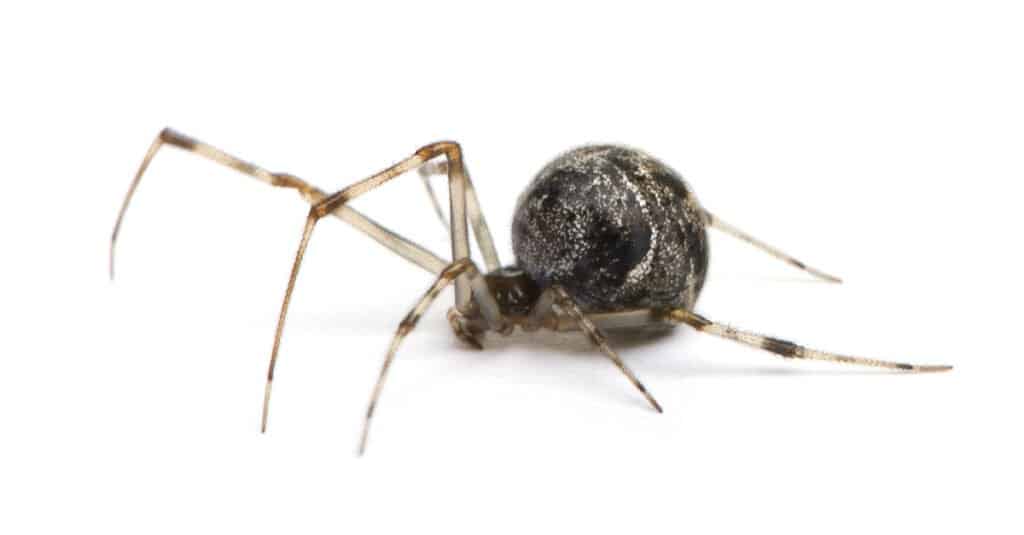
is one of the most common spiders in Iowa.
©Eric Isselee/Shutterstock.com
As its name implies, the common house spider, Parasteatoda tepidariorum, is one of the most common spiders in Iowa. Also known as the American house spider, it belongs to the family Theridiidae and is widely distributed throughout much of the world.
Females usually measure from 5 to 6 millimeters long, while males measure 4 to 5 millimeters in length. Their color varies from tan to black and they feature an array of different abdominal markings. People often mistake them for black widows due to their similar size, color, and shape.
Common house spiders typically build their cobwebs inside human dwellings, hence their name. Their diet includes a variety of household pests including flies, mosquitoes, ants, and grasshoppers. While they aren’t aggressive by nature, they will occasionally bite people if provoked. However, their bite is not medically significant.
#2: Black and Yellow Garden Spider
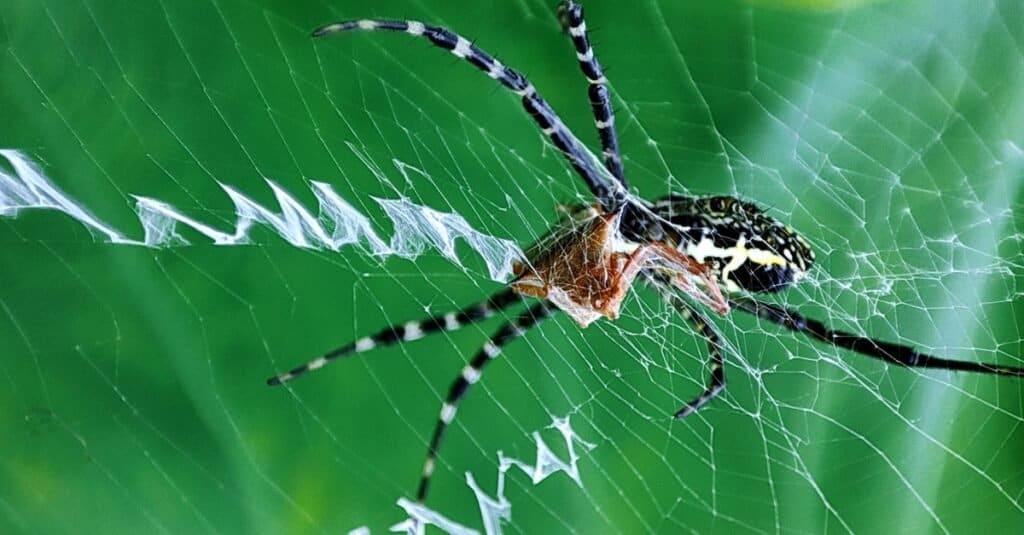
The black and yellow garden spider spins a zigzag-shaped web.
©iStock.com/Utpal Biswas
Also known as the writing spider, corn spider, or zigzag spider, the black and yellow spider is common among spiders in Iowa gardens. It is a member of the orb weaver family Areneidae and its range extends from Canada to Costa Rica.
Female black and yellow garden spiders measure from 19 to 28 millimeters long, and males measure 5 to 9 millimeters in length. They get their name from the black and yellow coloration on their abdomens. Meanwhile, their carapaces appear mostly whitish-silver and their legs feature black and tan bands.
Black and yellow garden spiders typically build their webs in fields or under the eaves of houses. Their webs measure nearly 2 feet wide and feature a distinctive zigzag pattern. Although they will bite if threatened they are not known to be aggressive. Common symptoms of a black and yellow garden spider bite include mild pain, redness, and swelling.
#1: Red-Spotted Ant Mimic
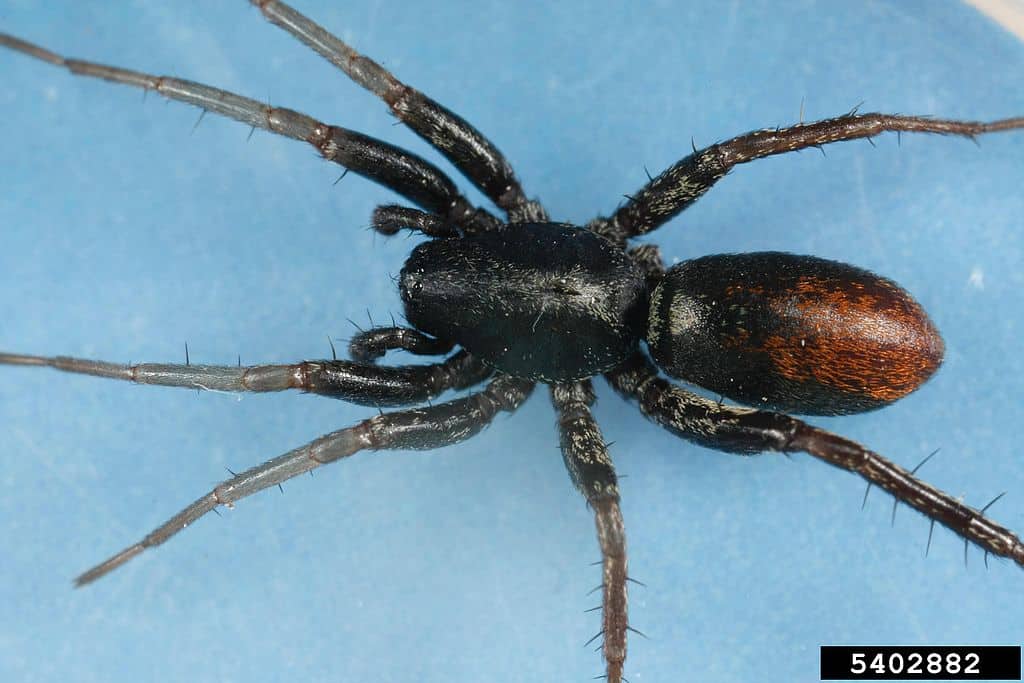
The red-spotted ant mimic acts like an ant in order to sneak up on its prey.
©Joseph Berger, Bugwood.org; University of Georgia / CC BY 3.0, via Wikimedia Commons – License
Castianeria descripta, or the red-spotted ant mimic, is a member of the corrinid spider family Corinnidae. It is widely distributed throughout the United States and is often found in shrubs or wooded areas near anthills.
Females usually measure around 13 millimeters long, with males measuring slightly smaller than females. Their bodies are mostly black except for a reddish-brown mark on their abdomens. They often get mistaken for black widows due to their size and shape; however, you can distinguish them from widows by the white line running down the center of their carapaces.
The red-spotted ant mimic is one of the most unusual spiders in Iowa. It gets its name from its habit of walking on six legs and using its front two legs like antennae, similar to an ant. Their bite is relatively harmless to humans.
Summary of 10 Spiders in Iowa
Here’s a recap of the 1 0 spider species found in the state of Iowa that we took a look at:
| Rank | Spider |
|---|---|
| 1 | Red-Spotted Ant Mimic |
| 2 | Black and Yellow Garden Spider |
| 3 | Common House Spider |
| 4 | Carolina Wolf Spider |
| 5 | Giant Lichen Orb Weaver |
| 6 | Dark Fishing Spider |
| 7 | Woodland Jumping Spider |
| 8 | Barn Funnel Weaver |
| 9 | Southern Black Widow |
| 10 | Tuft-Legged Orb Weaver |
The photo featured at the top of this post is © iStock.com/maria72
Thank you for reading! Have some feedback for us? Contact the AZ Animals editorial team.






